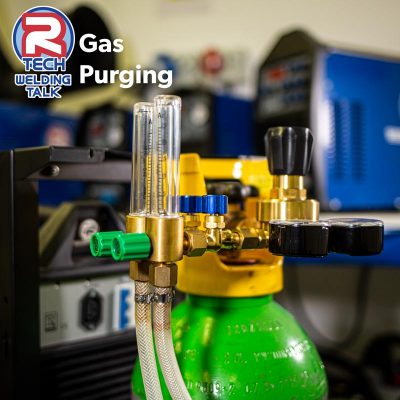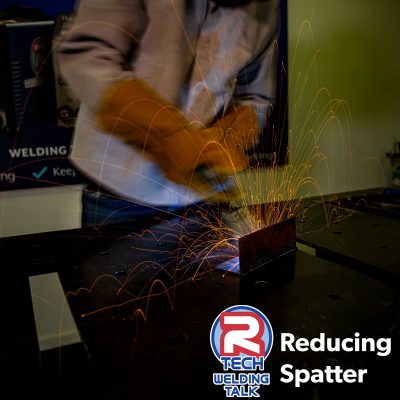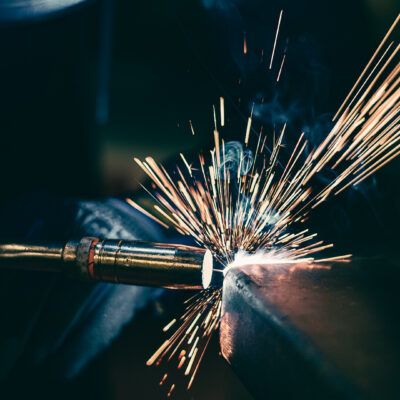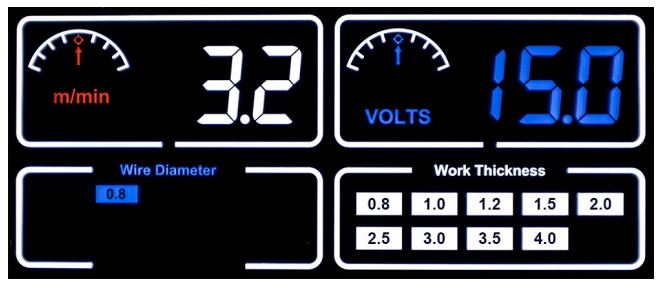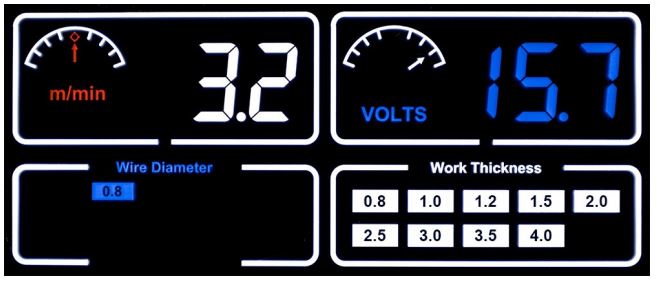R-Tech MIG Welding Support & Information
MIG Welding Articles
MIG WELDING VIDEOS
Mig Welding FAQs
-
What is Easy-Set technology on the MIG181 and MIG251?
Easy-Set technology takes the guess work our of setting up machine for your desired weld. You simply use two buttons to select wire size being used and material thickness to weld.
The machine then sets the wire speed and welding power accordingly, you then just press the trigger and start welding - it is that simple!
Easy-set is ideal for all users - the beginner / occasional / proffesional welder as you can get welding by the press of 2 buttons - no need for charts / remembered settings etc as it's all built in for you. You can get welding quickly!
You also have a trim for wire speed and welding power, so you can trim it +/- to suit your personal preference of travel speed / weld bead thickness.
In image below, using 0.8mm wire, you have selections for 0.8, 1.0, 1.2, 1.5, 2.0, 2.5, 3.0, 3.5, 4.0mm - Just select thickness and get welding.
If you want to fine tune the weld characteristics to suit your personal preference.
You can trim the wire speed by 1 m/min by turning wire speed knob.
You can trim the welding voltage by 1V by turning welding voltage knob. -
What are Inverter MIG welders and their benefits?
Inverter MIG welders are lightweight and portable compared to traditional MIG welders which had large heavy transformers. They are more efficient and cheaper to run. An inverter uses silicon technology which increases the internal frequency allowing higher output amperage on lower amperage inputs.
Inverters allow fine control of the welding power, with infinite control you can adjust weld power in very small increments, on traditional step transformer welders, a power setting of 3 may be too low but 4 is too high and blows holes in the work.
Our MIG welders weld from as low as 25amps making it easier to weld very thin metal, even for the novice, allowing a controlled long weld bead on thin material without blowing holes. Traditional welders generally started at 40 amps plus..
Other benefits are reduced weld splatter and smoother arc due to the inverters cleaner and smoother DC power output.
All our Inverter MIG welders use the latest Siemens Infineon IGBT technology which are very reliable and built to last. -
What Gas Is Used For Mig Welding?
The most commonly used gas for MIG welding is 95% argon 5% CO2 and is good for welding anything up to around 7-8mm thickness.
For welding very thick materials you may use a mix of 80% argon and 20% C02.
When welding aluminium on a MIG welder you would use pure argon gas.
The gases role is to act like a shield around the arc, you will sometimes hear people refer to it as a shielding gas. It protects the weld pool from becoming contaminated from the surrounding atmosphere, i.e. we rely on oxygen to breathe however if this gets into the weld pool you will get something called oxidation which effects the strength and integrity of the weld.
You also have the option of using gasless MIG wire, this does give good results and ideal when welding outside or when gas is not an option.
For fine tuning of gas flow rate we advise to use a gas flow meter as well as the normal gas bottle regulator, this allows you to fine tune the gas flow rate. Gas costs money so its best to ensure you are not having to much gas flow as it doesn't improve the weld.
-
Why is a Euro MIG torch superior to a fixed torch?
We fit Euro style torches on all of our MIG welders.
These have many benefits over machines with a fixed torch as found on the cheaper DIY machines.They give a consistent wire feed speed giving a more uniform weld. If the wire feed is erratic, then your weld bead will be erratic.
Easy fitment if torch becomes damaged - for fixed torches you will have to dis-assemble part of the machine.
Euro torches come in 3M, 4M and 5M lengths, fixed torches are normally quite short at about 1.5m.Euro torches are generally better quality so feel better in the hand.
-
What are the Advantages Of MIG Welding?
MIG welding is one of the fastest ways to weld and quite easy to learn mainly due to the continuously-fed wire by the wire feeder when compared to TIG welding when the rod is inserted by hand.
It’s suitable for joining many different metals and metal thicknesses too. It gives a characteristically good weld bead and the ability to vary weld penetration by changing the amount of current makes achieving strong, smooth welds remarkably easy.
All-position welding capability: MIG handles horizontal, vertical or flat welding with confidence.
There’s minimal clean-up requirement. Only TIG welding is cleaner; compared to traditional stick welding, MIG doesn’t use flux, or create extensive, messy weld spatter and slag.
With our latest range MIG Welders with the R-Tech Easy-Set technology, you simply select thickness of material and diameter of wire being used and the machine sets the amperage and wire speed for you, just press the trigger and you are welding. This is a great advantage over machines which you have to set these yourself, great for the novice and pro as it speeds up the setting up of machine and takes out any guess work.
-
What is the benefit of your metal wire feed units compared to plastic ones?
We only use metal wire feed assemblies on our MIG welders. Plastic units are generally found on the cheaper DIY end of the market.
These give a much longer life span than plastic ones which wear out quickly and can struggle to give good consistent wire feed even from new and after a while can loose tension so the wire starts slipping on rollers giving inconsistent feed, so the weld bead will look erratic.
Metals feed units give very consistent wire feed speed which results in a lovely uniform weld, poor feed = poor weld.
All our feed units have reversable rollers to suit 2 sizes of wire, our MIG181 for example comes with a 0.6mm & 0.8mm roller so you can weld very thin material and thick material by just turning the roller around.
We have many customers who have struggled with a cheap DIY machines to get a decent consistent weld, they thought they were a bad welder, once they have have welded with an R-Tech machine, they comment that it's now obvious they had a bad welding machine! -
Can you use a MIG welder to weld aluminium?
Yes you can, Inverter MIG welders are capable of laying down a very good aluminium weld.
Our inverter MIG181, MIG251 and MTS251 MIG welders can be used with our optional MIG spool on gun. This is a welding torch with a motor and small spool holder fitted to torch. This allows you weld aluminium with a MIG much easier than using the standard 3M torch.
Aluminium wire is very soft so with a spool on gun the wire only has a very short distance to travel before coming out the end of the torch. This stops the annoying wire breaks and snarling of wire when using a long torch to feed the wire through.
You will need to change gas to pure argon and in the machine menu put into spool gun mode. It's really quite easy to MIG weld aluminium now.
It does have limitations though, it is ideal for welding repetitive jobs with straight welds like on trailer bodies, general fabrication etc. For more technical welds and thin aluminium the TIG process would be more suitable especially for alloy wheel repair, intercoolers, header tanks and engine cases etc.For our industrial MIG welders we would suggest a push pull gun where the torch has motor and rollers that pull the wire that is pushed by the drive rollers in machine, this keeps tension in the wire and stops it breaking / snarling and can handle high amperage thick work.
We have a page you can read on the properties and characteristics of aluminium in the MIG welding process. Please see our Aluminium Welding Information page for more details.
If you would like more information on MIG welding aluminium please call us today on 01452 733933 and we will happily help you with your own particular application.
-
What is the benefit of a 4 roll wire feed system on industrial MIG welders?
We fit a 4-Roll geared wire feed drive assy to the following on our MTS251 and MTS450 MIG welders
The benefit of a 4-roll system over a 2-roll system is you achieve a smoother and very consitent feed of the mig wire when using longer 4 or 5 metre torches.
4-Roll systems are for the heavy industrial machines and most manufacturers only fit to thier top end models. A 2-roll feed unit gives very good consistent wire feed as well, a high amperage industrial machine is generally used in a heavy production enviroment.
We also use heavy duty wire feed motors which offer greater reliability and long life when compared to the smaller feed motors our competitors use.
The feed drive plate which houses the motor and rollers is made from metal which also add's to the durability and reliabilty compared to the plastic wire feed units you see on a lot of mig welders today. -
What is the benefit of ARC FORCE on your inverter mig welders?
Some of our R-Tech inverter MIG welders feature 'Arc Force'
This is also known as 'choke' on traditional mig welding machines where you would have 2-3 sockets for the earth to plug into. The low setting better for thinner materials and gives a smoother arc, where as the high setting is better for thicker materials (more penetration) and the arc is harsher and can give more splatter.
The Arc force on our machines works in the same way but can be adjusted electronically from 0 - 100%, this allows you to fine tune the weld arc characteristics to the thickness of metal you are welding.
With adjustable arc-force, infinate control of wire speed and welding power, you can really fine tune our welders to give you the most smoothest weld ever.

